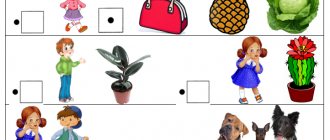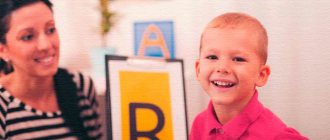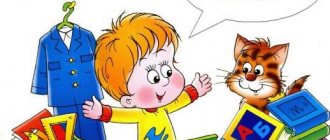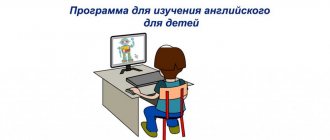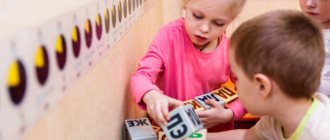The foundations of correct pronunciation begin to be laid in childhood. If a child has any speech defects, this should under no circumstances be ignored. After all, such a nuisance will accompany a person throughout his life. From a very young age, it is important to monitor the process of proper sound formation in a child. But how to set the sound? How quickly can you deal with this defect if you notice deviations from the norm? In this article we will look at how the correct production of the “R” sound occurs.
Reasons for incorrect pronunciation
Every parent wants their child to develop fully, including his speech development. The sounds “R” and “R” are especially difficult for children. Making these sounds requires a little more effort and patience than in other cases. The child must make clear movements with the organs of the speech apparatus, automatically taking their correct position, and it is also necessary to obtain the correct vibration of the tongue for this sound.
If your child has difficulty reproducing the letter “P,” then the best thing to do is contact a speech therapist. He will most quickly be able to suggest how to teach a child to say this sound correctly. Most often, doctors encounter the following pronunciation problems:
- Replacement with other sounds. Most often, children pronounce the letters “Y”, “L” and “Y” instead of “R”.
- Swallowing sound in words. This usually occurs when “P” comes before or after a vowel.
- Excessive vibration. In this case, it is clear that the child is saying the letter “R”, but the unnecessary vibration slightly distorts the sound.
How can you tell that something is wrong with your pronunciation? For this purpose, you need to ask the child to reproduce only the sound “R”, and then some word with it, for example, tree.
If there is a problem when pronouncing an isolated sound, then you need to focus your efforts on it. If the child incorrectly reproduces the letter in words, then in classes it is important to train on words where letters such as “O”, “A”, “U”, “I” come before or after “P”.
Incorrect speech can be caused by several reasons. In order to determine them, you need to consult with an experienced speech therapist. Having established the true reason, he will be able to suggest how to teach the child to pronounce the sound. And the following factors may be the culprits.
Speech breathing problems
Speech breathing is the basis for the correct pronunciation of all existing sounds. It can be disrupted due to the development of chronic runny nose, pathologies of the adenoids, heart and blood vessels, and lungs. A speech therapist will help you practice the correct breathing process during a conversation.
He will be able to develop a training scheme taking into account all the characteristics of the child’s body. Typically, rapid production of the sound “R” in children is carried out using a complex that includes words with this letter and special exercises.
Hearing impairment
This developmental defect in children can also greatly affect the child's speech development. Children try to imitate their parents in everything, in particular in speech.
If after 4 years of age a child swallows sounds or greatly distorts them, then a phonemic hearing disorder may occur. When a child simply cannot correctly repeat what was said to him.
Insufficient development of speech organs
In order for speech to be understandable and correct, it is necessary to have a developed articulatory apparatus. Articulation gymnastics helps to prepare him well. Thanks to it, muscle tissue is strengthened, and the skill of correct placement of the speech organs is practiced during the pronunciation of a particular letter.
Articulation exercises can be carried out in a playful way, which will interest the baby more. On our website there is specially selected articulation gymnastics for the sound “R”.
Individual structure of the frenulum
It also happens that producing the sound “R” causes difficulties due to the physiological characteristics of the baby, namely the unusual structure of the frenulum. This defect prevents the tongue from moving freely, which prevents correct production. Only a specialist can detect underdevelopment of the ligament.
In this case, the way to teach a child to speak without defects may also be special articulatory gymnastics and exercises or surgical intervention. In the latter case, there is no need to worry, the operation is absolutely easy and safe.
Reasons for incorrect pronunciation
A child may not be able to pronounce vibrant for various reasons. Let's list them:
- Anomalies of the frenulum - it may be shortened and incorrectly positioned. In some children, the hyoid ligament can be stretched with exercises. But sometimes the bridle has to be cut;
- Features of the structure of the tongue - its narrowing or enlargement (macroglossia);
- Anatomy of the jaws - a narrow upper jaw, an incorrect bite can also interfere with the pronunciation of the vibrant;
- Anomalies of the palate - with a cleft or gothic palate, vibrants are difficult to achieve;
- Incorrect location or absence of teeth in the upper jaw;
- Hearing abnormalities - in this case, the baby may not perceive vibrant by ear, an even more difficult situation is physical hearing impairment;
- Hypotonia - weak muscles are characteristic of dysarthria;
- Imitation. It often happens that a child pronounces vibrant, but comes to a children's group, where the children “burr.” And he begins to repeat after them - the skill is lost.
Its correction also depends on the cause of the speech disorder. This requires consultation with a neurologist and speech therapist. The specialist will write out a program for stage-by-stage sound production. The earlier the correction is started, the easier it is to achieve good results.
Stage 1: preparation for correctional work
It consists of identifying the sound “p” and its substitute by ear and comparing their articulation. To develop the articulatory skills that are needed to make the sound “r”, the speech therapist prescribes special exercises for the little patient - for the lips, tongue and lower jaw.
At the stage of preparation for sound production, it is necessary to introduce the baby to the parts of his language. The easiest way to show them is on the palm of your hand: tip, back, edges, tummy. This will make it easier for your baby to do the exercises.
Stage 2: setting the sound “r”
There are several approaches: staging by imitation, from other sounds, mechanically and with the help of gymnastics. Next we will look at these staging methods in more detail.
Stage 3: vibrant automation
To do this, the child pronounces syllables and words, and then more complex tongue twisters, tongue twisters, rhymes and phrases - with different stress and vowel. This allows you to bring pronunciation to automaticity.
Stage 4: introducing vibrant into speech
The final sound “r” is formed in children within 25–40 days, sometimes it takes up to 60 days. Although there are often cases when the correction continues throughout the year. You need to work with a speech therapist at least twice a week, and continue the rest of the days at home on the recommendation of a specialist.
Preparation of the articulatory apparatus
Before you learn how to make a sound and start performing speech therapy exercises on the sound “R”, it is necessary to prepare the muscle tissue of the speech organs so that they can work at full strength. Articulation gymnastics is used for this purpose. The following exercises can be used:
"Crap". The baby needs to smile, open his mouth slightly, then put his tongue on his lower lip and hold it in this position for several seconds. You need to start with 3 seconds, gradually increasing the time, but the result should be no more than 10 seconds.
“Punish the tongue.” To do this, you also need to position the speech organs, but no longer hold the tongue, but slap it with your upper lip, while pronouncing “Pya.”
"Jam". This exercise is performed as follows: open your mouth slightly, and then move your tongue along your upper lip from side to side. You can actually put a little something sweet on your lip so that your child is more willing to do gymnastics.
"Painter". The baby doesn’t have to open his mouth, but simply move his tongue across the palate, as if painting it. This is a good way to practice moving your tongue back and forth.
"Mushroom". The child will need to open his mouth slightly, smile, and completely “glue” his tongue to the roof of his mouth. Hold your tongue in this position for several seconds.
All of the above exercises for making the sound “P” must be performed before each lesson. They are indispensable in preparing the speech organs for basic training.
Summary of an open lesson on sound automation [R]
Goal: Automate a clear pronunciation of the sound [R] based on the topic “Adventures with the robot Robik.”
Tasks:
Correctional and educational:
- consolidate the correct pronunciation of the sound [P] in isolation, in syllables, words, sentences, pure phrases;
- clarify the correct articulation of the sound [P];
- exercise the ability to determine the place of a sound in a word and connect an object with a diagram;
- consolidate the visual image of the letter [P].
Correctional and developmental:
- develop children's facial muscles;
- develop visual and phonemic perception, memory, thinking, fine, gross and articulatory motor skills, coordination of speech with movement.
Correctional and educational:
- formation of a positive attitude towards participation in the lesson;
- formation of goodwill, independence, initiative, responsibility.
Equipment:
- flat figures of the robot Robik and Kolya;
- drawing with an image of an umbrella;
- cards depicting emotions (robot);
- audio tracks;
- table with letters;
- game "Mountain Path" (playing field with cubes and chips);
- easel;
- table - a house with graphic diagrams showing the place of automated sound in a word;
- cards (automated sound at the beginning, middle and end of a word).
Progress of the lesson
1. Organizational moment Hello, my name is Robik! I am a little robot who came to Earth to learn everything that a person can do. I have a friend, Kolya, with whom I explore the world. I have already learned to express my emotions: smile, be sad, be surprised and even get angry. Pictures of emotions with a robot are hung on an easel.
And now I want to learn how to speak correctly. There are many different sounds in our language, and I really want to pronounce them clearly and correctly. I invite you to this wonderful world of sounds.
Finger gymnastics “Robot”
| A robot came to us today. | (clench and unclench your fists rhythmically). |
| Two arms, two legs, head in place | (knock on the table with their fists, feet on the floor, turn their heads, hands on their ears) |
| In the world of sounds he wants to play with us. | (rhythmically clench and unclench your fists, then clasp your hands, interlocking your fingers). |
Today we will repeat the sound [R]. How to form the sound [R] correctly:
- the lips are in the position of the next vowel;
- teeth at a distance of several millimeters;
- the tip of the tongue is raised to the alveoli, tense and vibrating; the edges of the tongue are pressed against the lateral teeth;
- there is an air stream in the middle of the tongue, which can be felt with the palm of the hand brought to the mouth;
- under the influence of a strong air stream, the tip of the tongue begins to vibrate;
- the soft palate is raised, pressed against the back wall of the pharynx, closing the passage into the nasal cavity, the air stream goes through the mouth;
- The vocal folds are tense, brought together and vibrate, resulting in the formation of the voice.
The position of the tongue behind the upper teeth and the vibration of the tip of the tongue are visually controlled. Tactile warm intermittent stream. In order to pronounce it correctly, you need to perform special exercises for the tongue.
Articulation gymnastics
“Doors open”, “Pancake”, “Horse”, “Mushroom”, “Swing”, “Focus”, “Painter”, “Machine gunner”.
2. Isolated pronunciation of the sound “R”.
"Soundtracks".
On my planet, we robots love to draw sound tracks. Draw a line along the path without lifting the pencil from the sheet, pronouncing the sound (r-r-r-r-r-r) with one exhalation.
3. Consolidating the visual image of the letter R. Development of visual perception.
"Find the letter." Find and circle all the letters P, while clearly pronouncing the sound [P].
4. Automation of sound in syllables.
The friends decided to go on a hike and began to collect the necessary things. Help Robik and Kolya fix their umbrella in case of rain.
"Fix the umbrella." Connect the letters P in the picture only with vowels. Read the resulting syllables, clearly pronouncing the sound [R]. Umbrella drawing. 5. Development of phonemic hearing.
Game "Catch the Sound".
Robik and Kolya want to offer you a game. Catch the sound. I will name the pictures, and if you hear the sound [P], take this picture in your hands, or clap your hands. 8-10 pictures are laid out on the table.
6. Automation of the sound “R” in words.
“Pack a backpack for your friends.” They need to take with them only those items whose name contains the sound [P]. Name them, don’t forget to pronounce the sound [R] correctly. Cards
7. Coherent speech. Automation of sound in a sentence.
"Seen on the Road"
Robik and Kolya saw a lot on the road. Choose a picture and make a sentence with it. Pictures are displayed on the easel.
Physical school
The robot is standing on the road, the movements are performed according to the text. His legs do not bend, He can wave his arms, He can blink his eyes, He can nod his head, One, two, three, four, five.
8. Automation of the sound “R” in words and phrases.
During the trip, the friends had to climb to the top of a high mountain. To do this, they had to overcome the “Mountain Path.” Help them cope with the task of naming all the pictures encountered along the way.
Description of the game.
Players roll the dice and determine who goes first. The first player takes as many “steps” as there are dots on the die. Once in the appropriate circle, he names the pictures above and below the circle and in his voice emphasizes the sound [p] in the names of the objects. If each word contains the sound [r], the player can make another one - a bonus move. If only one word contains the sound [r], the player remains on the same circle where he was, and the turn passes to the other player. If there is no sound [r] in more than one word, he returns back to the start and starts the game again.
Game "Mountain Path".
Pure sayings are repeated together by two players in the corresponding pictures.
Start Ra-ra-ra - the game begins (at the start). Ro-ro-ro we will go far (picture of a bus and a rose). Ru-ru-ru I see a kangaroo (picture of a kangaroo and a shirt). The fish - the fish - got to the wasp (picture of a wasp, a sparrow).
Finish RA-ra-ra is an interesting game (at the finish line).
9. Determination of the place of sound in a word.
On the trip, they met Carlson and became friends. Carlson asked his friends to complete the task. But it turned out to be difficult for them. Please help them cope. The child is shown a table of a house consisting of three “entrances”. Each “entrance” has 3 “floors”, and on top (in the attic) there is a graphic diagram showing the place of the automated sound in the word (sound at the beginning, in the middle and at the end of the word). The child must arrange all the pictures into their “apartments”. Then ask the speech therapist to name all the pictures in which the sound is at the beginning of the word; in the middle of a word; at the end of a word. Name what is shown on the cards.
Cards (rose, robot, cancer, cake, thermos, pencil, tomato, cheese, axe).
10. Development of auditory attention and memory.
In the evening before going to bed, friends decided to learn to write poetry. Try it too. Complete the word and repeat the entire sentence. Children are offered the riddle game “Give me a word.” A picture is hung on the easel (hint).
He is tall like a closet, and his name is... (giraffe). Luda looks in surprise at the humpbacked... (camel)
This is such a miracle garden, we stand open-mouthed... (mouth).
In the severe cold in January, the Hedgehog sleeps in his ... (hole).
On the porch at the gate, the red one meowed.....(cat).
11. Homework: learn the poem “Robot”
There is no steering wheel and no tires, But I am a relative of cars. Even though I have a square head, I’m almost like you, alive: I stand and I walk. Whoever wants to, I’m friends with him. I may be a little stubborn, but I am a very kind robot.
12. Summing up.
Well done, you tried very hard today, so you clearly and clearly pronounced the sound [R] in syllables, words, and phrases, and you taught this to our guests. Our guests are grateful to you. Now watch your speech and don’t forget about the sound [R].
Author of the material: Gordienko Olga Leonidovna
Also on topic:
Summary of an individual lesson on the topic: Automation of sound [R]
Breathing exercises
In order to pronounce the sound “R”, a directed stream of air is required. Therefore, it is important to practice the child’s breathing, especially if he has difficulties with this process.
A home exercise routine may include the following tasks:
- "Candle". To complete the task you will need a regular candle that needs to be extinguished. You can simply blow hard on it so that the light immediately disappears, or blow long and slowly so that it squirms. At first, the distance between the mouth and the candle should be small, and then it should be gradually increased to make the activity more difficult.
- "Storm". You will need a glass of water and a juice straw. The baby should inhale air through his nose and exhale through his mouth through a straw. Thus, a small storm is formed, causing the water to actively move.
- "Snowflake". The child should open his mouth, stretching his lips in a smile, and place his tongue on the lower lip. Then you should put a small piece of paper on the tip of the tongue and invite the baby to blow it off.
Each exercise should be performed no more than 4 times. In this case, inhalation should always go through the nose, and exhale through the mouth. It is also important that the child does not have any health problems, that is, there is no sore throat, no unusual coating on the tongue, and so on.
Sound production methods
Speech therapy offers a variety of ways to produce the sound “R”. You can use one method or several at once. During a consultation with a specialist, you can accurately decide on your classes.
Imitation
This is the simplest and most effective method of how to set sound. The speech therapist or parent sits with the child in front of the mirror and shows him the correct location and movement of the speech organs while pronouncing the sound “R”.
After this, the baby just needs to repeat after the adults, controlling the process using a mirror.
You can also imitate not only people, but also animals or some things. For example, excellent methods for putting the letter “R” are the following tasks: growl like a dog “R-R-R”, imitate machine gun shots “Tra-ta-ta”, purr like a cat “Pur-r-r”. This will interest the child more than simply imitating adults. But at the same time, you also need to monitor the location of the organs of articulation.
Setting the sound “R” from the sound “D”
Speech therapists often use a method to teach a child to say the letter “R”, as a production from the sound “D”. The baby needs to imagine that his tongue is a sail and needs to be inflated with the help of the wind. To do this, you need to pronounce the sound “D”, while blowing forcefully on the speech organ.
Over time, a “Drrr” sound will be heard during this activity. As soon as it becomes noticeable, you need to automate it immediately. To do this, you should use words where there is a combination of these two letters, for example, friend, fight, tree, and so on. More details can be found in our article, automation of the “R” sound.
Setting "R" from the sound "Z"
The essence of this exercise for the sound “R” in children is that the child must pronounce the sound “Z” protractedly. In this case, it is necessary to keep the tongue in the upper position. Then you should quickly move the tip of the organ along the tubercles, which are located behind the upper jaw. As a result, the sound “Wed” will be heard.
Making the sound “R” while inhaling
Another way to make sound is to inhale. The baby needs to pronounce the sound “C” for a long time, then take a short breath, sharply press the tongue against the alveoli and try to suck the tongue inside, like a snail into a shell. In this case, it is important to touch the tubercles with your tongue, otherwise there will be no sound.
Installation by mechanical method
To carry out this exercise, you can use a cotton swab or a toothpick with cotton wool. They should be perfectly clean, the edges should not prick the tongue. The wide tongue should be on the cusps behind the upper teeth. The child will need to say “Z” or “D” for a long time. In the case of “Z”, the result will be zzh, and in the case of “D”, it will not be a clear d.
At this time, the parent should place a stick under the tongue and move it to the sides to cause vibrations. The tongue should be tense and hold a strict upward position, letting in a stream of air only at the tip. As a result, the desired sound should be heard, similar to a rumble. To make it more fun for your child, you can tell him that you are starting the engine.
All of the above methods of producing the sound “P” can produce different effects relative to time. Some children begin to pronounce this letter from the first exercise, while others achieve success only after several days or even months of regular practice.
How to start a motor: tips for parents on making the sound “r”
Typically, children develop correct pronunciation by the age of 5-7 years. By this age, the child should pronounce all sounds. If a violation is observed, then first the whistling sounds are played, then the hissing sounds, then the “l” and “l'” are placed, and lastly the “r” and “r’”, since they are considered the most difficult.
The most relevant and useful information for modern parents is in our newsletter. We already have over 30,000 subscribers!
What types of violations of the pronunciation of “r” are identified (according to N.S. Zhukova)
- throat “r” (burr). With this defect, the tongue is pulled back and the root part comes close to the soft palate;
- doral "r". The tip of the tongue is lowered, the vibration is generated by the back of the tongue, which hits the front of the palate or alveoli. The entire lower jaw trembles with the tongue;
- lateral "r". With this violation, the lateral edges of the tongue are torn away from the upper molars, and air passes into the resulting gap.
In case of these violations, you should not wait until the child turns five years old, but seek help from a speech therapist: the sooner the parents do this, the more successful the correction will be.
If we exclude incorrect pronunciation associated with defects in the structure of the organs of the articulatory apparatus (short hyoid frenulum, too large tongue, high palate, etc.), if we are talking about replacing the sound “r” with another (for example, frame - llama, cancer - vac), then parents can handle it on their own. However, the work of a speech therapist should not be excluded. Provided you regularly practice with a specialist and perform exercises with your baby at home, there is a high probability that the sound will be automated faster.
Staging any sound begins with articulatory gymnastics. You can do it at home. Preferably daily for 5-10 minutes in front of the mirror. Each exercise is done from 5 to 15 times. There is no need to do all the exercises at once, the child will get tired. Choose a few and start doing gymnastics.
L.A. Komarova gives the following exercises for making the sound “r”:
- “Fence” - smile so that your teeth are visible. Hold this position for several seconds.
- “Spatula” - open your mouth and place a wide, relaxed tongue on your lower lip. The “spatula” is brought into the mouth.
- “Cup” – raise a wide, relaxed tongue to the upper lip. The middle part of the tongue is bent, the lateral edges are curved upward.
- “Horse” - suck your tongue to the roof of your mouth and then peel it off with a sound. Click your tongue slowly and forcefully. The lower jaw is motionless.
- “Mushroom” - open your mouth wide, suck your tongue to the roof of your mouth and hold it in this position for a few seconds.
- “Delicious jam” - lick the upper lip with a wide tongue, leaving the lower jaw motionless.
- “Swing” - mouth wide open. Stretch your tongue either to your nose or to your chin.
- “Candy” - the tongue rests alternately on the right and then on the left cheek.
- “Let’s brush your teeth” - use the tip of your tongue to “brush” the lower teeth from the inside. The lower jaw is motionless.
- “Accordion” - the tongue is “glued” to the palate, opening and closing the mouth. The lips are stretched in a smile, the tongue remains attached to the top.
- “Drummer” – the tip of the tongue is behind the upper teeth, quickly pronounce “ddd”... and pound the tongue.
- “Turkey” - run the wide tip of your tongue across your upper lip back and forth and say “bl-bl-bl.”
After preparatory gymnastics, it is recommended to work on the development of the air stream: to make the sound “r”, you need to exhale forcefully.
We offer several exercises:
- blowing out candles;
- puff out your cheeks and “pop” the balloon by pressing your palms;
- football. At home, make two towers from a construction set, roll a small ball from cotton wool - this is a ball. The child blows on the ball, trying to hit the goal.
- bubble. Pour a small amount of water into a tall glass (plastic will do) and add a few drops of liquid soap. Ask the child to blow into a straw straw. In the process, soap bubbles grow.
- boats. Fill a large bowl with water and place a paper boat in it. Blow on the boat so that it docks on the opposite shore.
- blow on a pinwheel or paper leaf/butterfly tied with a string to a pencil or straw tube.
- snowflakes. Place a piece of cotton wool on the tip of the child’s nose and ask him to blow it off. The fleece will fly away as soon as the baby places his tongue correctly - it should be raised up, the edges bent.
3 ways to make the sound “r”
1. Setting from the sound “d”.
The most common way. The mouth is wide open, the tip of the tongue is raised behind the upper teeth towards the alveoli. We ask the child to pronounce “ddd” or “ttt” slowly at first, then the tempo gradually accelerates. When the baby gets used to holding the tongue in the desired position, then when repeatedly pronouncing “d” with a clean finger or a cotton swab, we try to make quick movements from left to right under the tongue to generate vibration. This exercise should be repeated until the tip of the tongue begins to vibrate and you hear “dr” (without mechanical assistance).
When fixing a sound, you should fix it in the syllables: DRA, DRO, DRU, DRE, DRY, TRA, TRO, TRU, TRE, TRA. Afterwards there is practice in words starting with “helpers”: fight, friends, brawler, grass, track, etc. Then we try to start the engine without helpers, so that we get a distinct “rrrr”. Practicing pronunciation begins with syllables where “r” is at the beginning, then “r” in the middle and then at the end of syllables and words. After the sound is fixed in different positions, its pronunciation is automated in sentences, phrases, poems, and texts.
2. Mechanical production of the sound “r”.
You can set the sound using a probe. We ask the child to raise his tongue up and say “zzz”. At this moment, we pass the probe/cotton swab/clean finger under the tongue from side to side. As a result, the sound “r” is heard. After setting it, we fix the sound according to the above scheme: “r” at the beginning of the word, in the middle and at the end.
3. Setting from the sound “zh”.
We ask you to say a long “zhzh” as you exhale; your tongue should be slightly in the back of your mouth. When doing this exercise you should hear the sound "r". (You can also help produce vibration at the tip of the tongue using a clean finger or a cotton swab.) Next, follow the scheme: fixing an isolated sound, automating the sound in syllables, words, sentences and texts.
When the sound “r” is introduced and its automation in speech, the soft “r” usually appears spontaneously.
It should be noted that sound production is inextricably linked with the development of speech as a whole. Not only the sound is placed, but also phonemic hearing is formed, for example, in tasks such as “Clap your hands if you hear the sound “r””, “Determine where you hear “r”: at the beginning, middle or end of the word” . This also includes the formation of the grammatical structure of the language, when the child performs exercises on inflection, for example, “one-many”: rak - crayfish, frame - frame.
What literature can you use?
- “Album of a preschooler. Automation of the sound “r” in game exercises”, author L.A. Komarova. The author presents the material in a playful way: labyrinths, “The fourth odd one,” replacing pictures with words, etc. In addition, to perform L.A. exercises. Komarova envisaged the use of paper characters: an ant, a crow, a dragon, a magic wand, a camera and a screen. They need to be cut out first.
- Home speech therapy notebook “Learning the sounds [P] and [P']”, authors E.A. Azova, O.O. Chernova. The child is accompanied by characters from the notebook: Irishka, Rechevichok and a puppy. The notebook contains many exercises for inflecting words, developing fine motor skills (circle the picture with dots), dividing words into syllables, and retelling texts.
- Didactic material “I say R and R correctly”, author O.E. Gromova. The book presents illustrated lexical material for automating the pronunciation of hard and soft “r”.
- Workbook for correcting deficiencies in the pronunciation of the sound “r” “Speech therapy games. R’s birthday”, authors I.V. Baskakina, M.I. Lynskaya. The material is presented in a playful form. Exercises help not only automate sound, but also develop visual perception, memory, introduce the graphic symbol “r”, and teach how to retell texts according to a diagram.
Quick registration Get 5% discount on your first order!
Let's summarize. If something confuses you about your child’s pronunciation, then go for a consultation with a speech therapist, even if others say that it’s too early for you. Each child is individual: some develop the sound within a few months, while others may pronounce “r” in class, but not use it in everyday speech (perhaps they want to attract attention, especially if there are younger ones in the family) .
Motivation plays a big role: when a child realizes that he is speaking incorrectly and wants to correct it, the correction process goes much faster.
I made the “r” sound for my son myself, he replaced the “r” with “v”. In the end, I managed to achieve his isolated pronunciation, but in spontaneous speech Lev was, as they say, too lazy to speak correctly. At that time, his girlfriend had her throat “r” corrected. As soon as the girl’s “r” was fully automated, she, according to her son, played a sound for it in kindergarten. One day was enough for her, and Lev began to use “r” in speech constantly. That also happens.
Did you have to seek help from a speech therapist or did you play the sounds for your child yourself?
Share in the comments!
